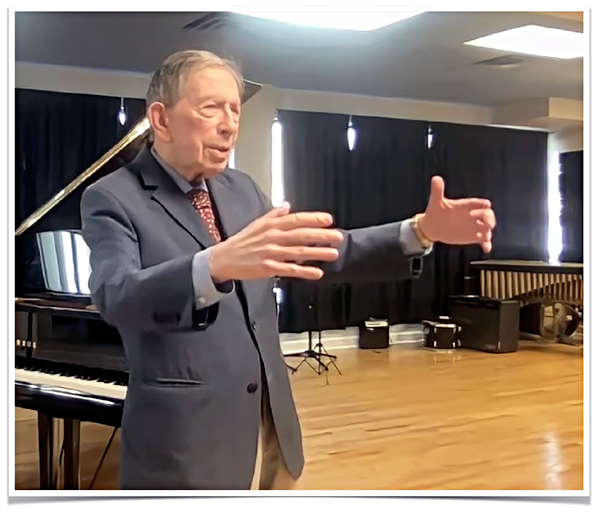Music Educators Association of New Jersey
Serving teachers and students since 1927





Following opening remarks by President Danette Whelan, Beverly Shea introduced the esteemed pianist Jerome Lowenthal, longtime professor of piano at Juilliard. His list of teachers, performances, and other professional activities and accomplishments is extensive and impressive. To learn about the presenter, begin with: https://www.juilliard.edu/music/faculty/lowenthal-jerome. Then explore the many pages of Internet references. Among the luminaries linked were Arthur Rubenstein, Nadia Boulanger, Olga Samaroff, Eduard Steuermann, and Alfred Cortot.

Mr. Lowenthal prefaced his talk with a general description of his students at Juilliard. They played well, they played expressively, but did Beverly Shea and Jerome Lowenthal they truly understand the relationship of dissonance to consonance, did they observe certain markings in the scores and did they consider what those markings implied? What followed was a fascinating exposition of interpretive essentials along with countless excerpts from masterpieces, each performed from memory. The list of composers whose works were discussed and excerpts performed included: Bach, Bartok, Beethoven, Brahms, Chopin, Robert Schumann, Stravinsky, and Webern. The pianist peppered his remarks with amusing anecdotes. It was an astounding presentation.

His central theme was. “I am more interested in the narrative of the music than the structure.” Should strict rhythm govern interpretation or should another approach lead to a better understanding of the music and the composer’s intentions? Would this understanding result in greater expressivity? We were treated to a discussion of the elements of music either in the score or implied by the score that could influence the interpretation or expressivity of the performance.
 Implied Rhythmic Elasticity: Mr. Lowenthal told of a discussion among concert pianists of the opening bars of Beethoven’s Sonata, Op. 106 (Hammerklavier): “Do you use two hands or do you follow the score and use the left hand for the two octave leap in the bass? Well, using one hand might take a tiny bit longer, and perhaps this is what Beethoven wanted: a little stretch in the timing to impart more emphasis,” he suggested. Then, in the mm. 5-8, do you hear it as one long phrase, or as a short/short/longer structure? The latter, his preference, will ask for greater expressivity. When studying a seemingly awkward passage, the performer should consider it might be a clue in the score that suggests a particular interpretation.
Implied Rhythmic Elasticity: Mr. Lowenthal told of a discussion among concert pianists of the opening bars of Beethoven’s Sonata, Op. 106 (Hammerklavier): “Do you use two hands or do you follow the score and use the left hand for the two octave leap in the bass? Well, using one hand might take a tiny bit longer, and perhaps this is what Beethoven wanted: a little stretch in the timing to impart more emphasis,” he suggested. Then, in the mm. 5-8, do you hear it as one long phrase, or as a short/short/longer structure? The latter, his preference, will ask for greater expressivity. When studying a seemingly awkward passage, the performer should consider it might be a clue in the score that suggests a particular interpretation.
Detailed dynamic markings: Mr. Lowenthal referred to the Brahms Intermezzo in A Major, Op. 118, No. 2, mm. 16-24, in which there is a succession of “hairpin” dynamic indications. These should be executed faithfully. He decried “the practice of teaching phrasing as a technical matter,” rather than as an interpretive one. Many related examples from the literature were played.
The Impact of Pedaling: In discovering the most authentic interpretation, paying attention to pedaling marking is also essential, he emphasized, citing that in Beethoven’s Sonata, Op. 111, Maestoso, in m. 2 and m. 4, it is not used on the first beat, but on the third. The first beat is not always the stressed beat. Look for composers’ pedaling intentions and consider their expressive implications.

Changes in Harmony or Maintaining Harmony: In deciding on phrasing, think about the status of the harmony. In Chopin’s Ballade in G Minor, Op. 23, in the Moderato. (m. 8 and all repetitions), observe that some treble notes are double stemmed, asking the pianist to sustain them, and perhaps suggesting that there be a little drag or slowness there. This is another example of deriving interpretation from the score. He argues against rhythmic rigidity.
Take Clues from Melodic and Rhythmic Patterns and Take Repeated Notes Seriously: In the opening notes of Chopin’s Sonata, Op. 58, the treble g followed by the b minor arpeggio sets the motivic pattern for development, both in the treble and in the bass, so you treat it as a melody. Regarding unrelenting pulse: with Chopin waltzes, avoid overemphasis of the first beat. Also, regarding a rigid musical pulse: remember that dynamics of baroque music played on the harpsichord did not include crescendo, so expressive effects were often accomplished with subtle departures from strict rhythm or pulse. As for repeated tones, shape the volume of a succession of repeated tones so that each one is slightly different from the one preceding or following it. Consider these possibilities to sound more expressive.
Jerome Lowenthal criticized interpretation that seemed overly centered on architecture rather than the narrative of a piece, and he would come away from a concert feeling that there was lack of attention to detail. This lack of detail can limit the expressive quality of a performance. In paying attention to detail, we can appreciate how great composers “transformed simple ideas” to become the foundations for expressive works of art. A short question and answer session concluded the program.

Bertha Mandel, writer
Lisa Gonzalez, Zoom coordinator, photos and layout
Beverly Shea, group photo